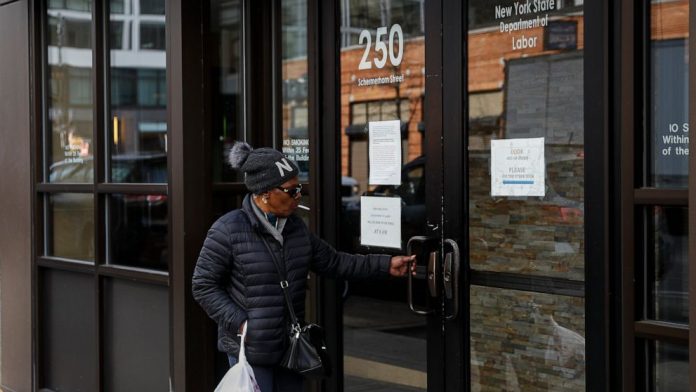
The United States saw an unprecedented surge in unemployment benefit applications, last week, with nearly 3.3 million people filing claims. This figure is more than four times the previous record set in 1982, highlighting the severe impact of widespread layoffs amid the economic shutdown triggered by the coronavirus pandemic.
This sudden influx of applications reflects the extensive damage the pandemic is inflicting on the economy. Unemployment claims typically correlate with layoffs, which are expected to rise as the nation enters a recession. Industries such as hospitality, entertainment, and travel are experiencing significant declines in revenue, prompting many businesses to reduce their workforce in an effort to cut costs. Some economists predict that the unemployment rate could soar to nearly 13% by May, exceeding the highest rate recorded during the Great Recession, which peaked at 10%.
The economic decline has been rapid and stark. In February, the unemployment rate was at a record low of 3.5%, and the economy was experiencing steady, albeit modest, growth. However, projections for the April to June quarter suggest a potential economic contraction of up to 30%, representing the steepest decline on record.
Many individuals affected by recent layoffs have struggled to file for unemployment benefits due to overwhelmed state systems that have been unable to cope with the volume of applications. This backlog indicates that the reported numbers of claims may not fully capture the extent of job losses.
In response to the rising unemployment, Congress is poised to approve an economic relief package that includes significant enhancements to unemployment benefits. Notably, this legislation proposes an additional $600 per week on top of the standard state benefits and extends unemployment aid by 13 weeks beyond the usual six-month period offered by most states. Furthermore, a separate bill approved last week allocates up to $1 billion to states to improve their claims processing capabilities, although it may take time for these funds to be utilized effectively.
Jessy Morancy, a 29-year-old wheelchair attendant and customer service agent at Fort Lauderdale Airport, was laid off recently and faced challenges obtaining unemployment benefits. Despite her efforts, she encountered a busy signal and automated responses when attempting to reach the state unemployment office. Concerned about the sufficiency of the $275 weekly benefit compared to her previous earnings, she expressed her frustration and uncertainty regarding her family’s financial future.
Kim Boldrini-Sen, a 41-year-old acupuncturist, also experienced difficulties filing claims in both Connecticut and New York. After several attempts, her applications were either lost or thwarted by technical issues, leaving her unable to receive any assistance.
The New York State Department of Labor acknowledged the challenges applicants face, encouraging perseverance in navigating their busy systems. Meanwhile, economist Ellen Zentner of Morgan Stanley predicts that up to 17 million jobs could be lost through May, a staggering figure that could double the job losses seen during the Great Recession. She forecasts an average unemployment rate of 12.8% for the April to June quarter, the highest rate recorded since the Great Depression.
Despite these grim projections, Zentner anticipates a potential economic recovery in the latter half of the year, although it may take time for the job market to stabilize, with unemployment possibly remaining above 5% by the end of next year.










